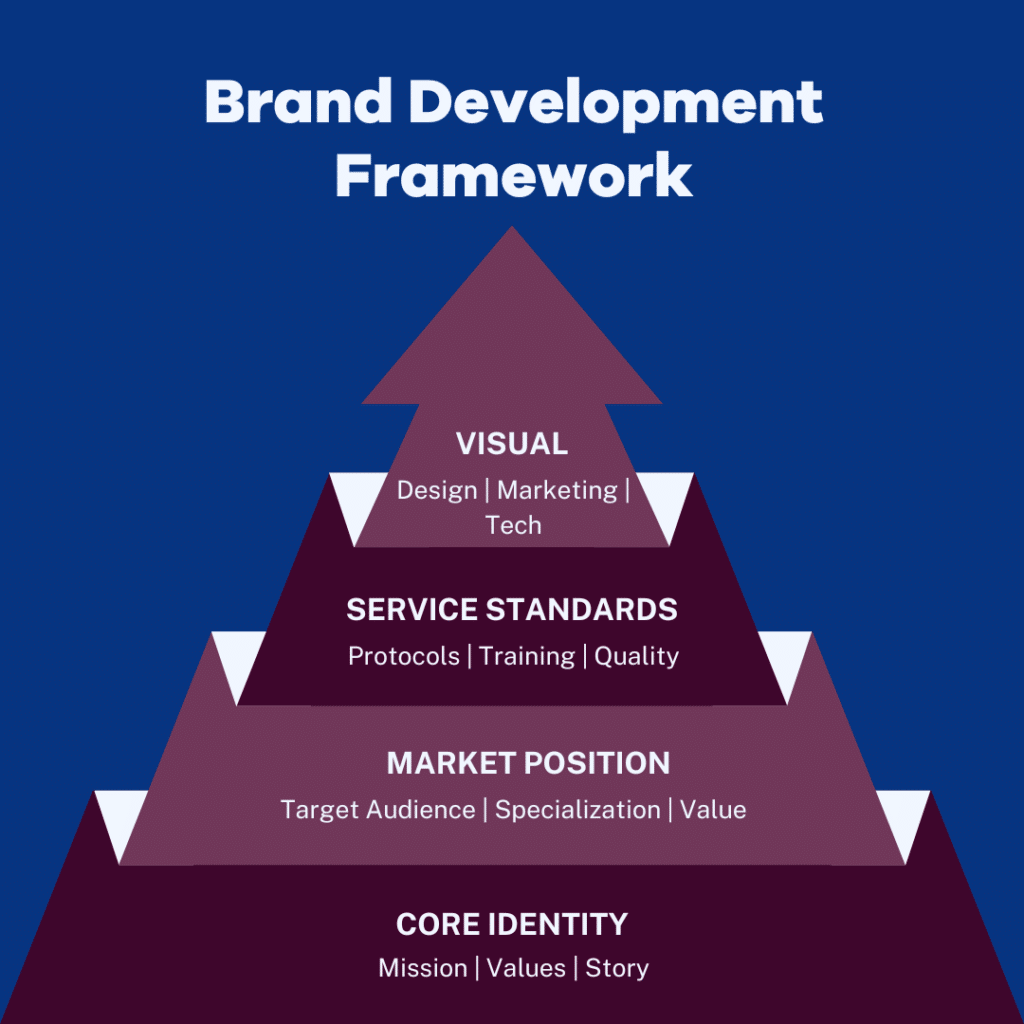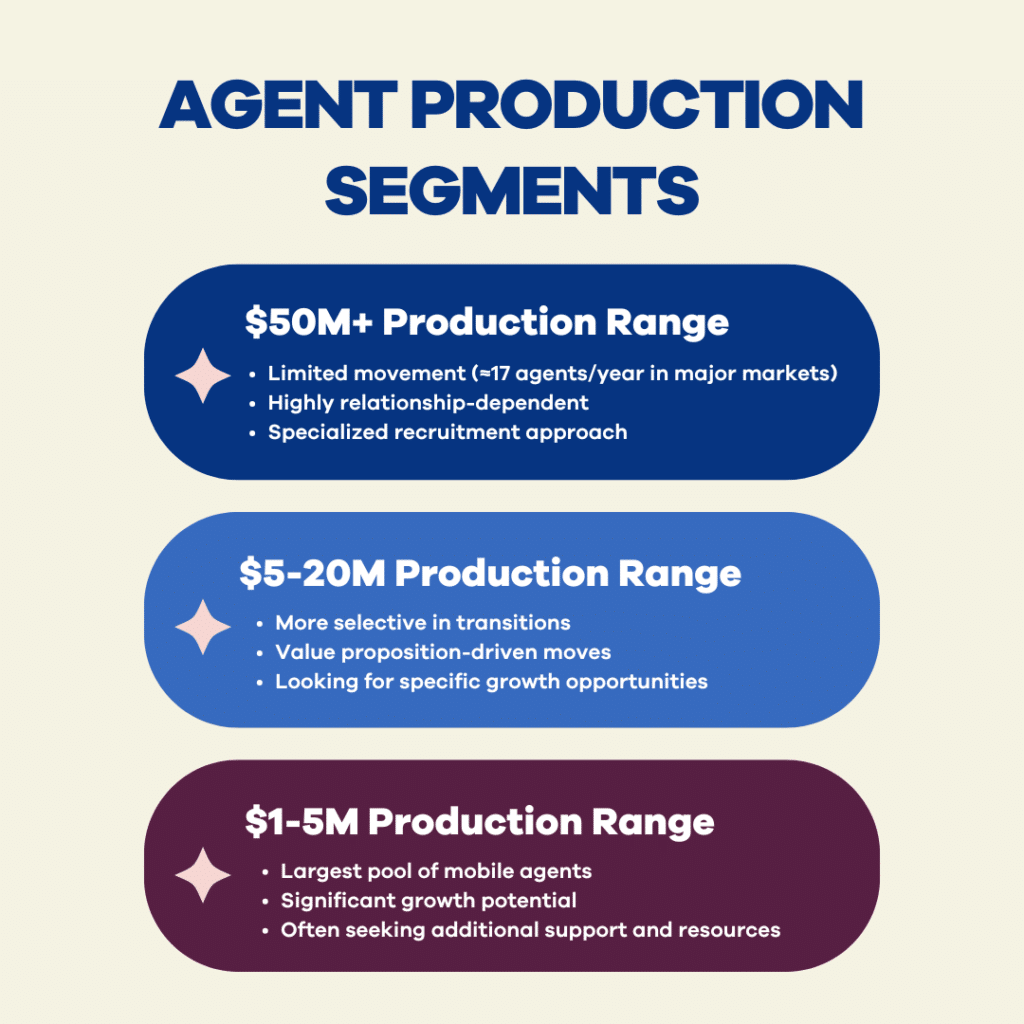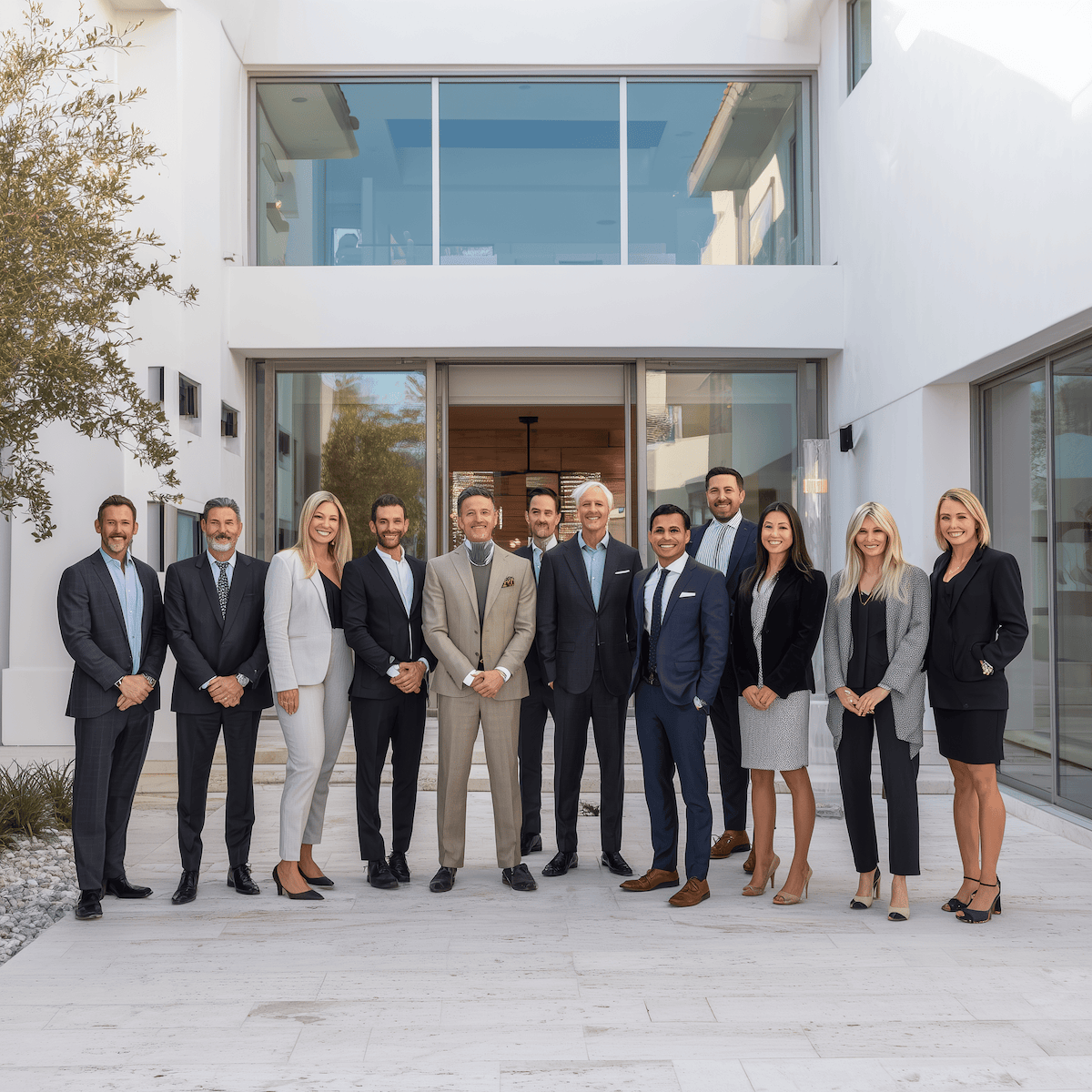Ensuring a sustainable future for your real estate brokerage requires mastering three critical elements: brand differentiation, strategic recruitment, and technology integration. This guide will provide all the resources to future proof your brokerage through:
- Brand Maturity: Brand-mature agents average 28 transactions annually versus 8 for generic agents, with 3-5% higher sales prices
- Strategic Recruitment: $1 billion in commission revenue moves between brokerages annually, creating opportunities for growth through targeted recruitment
- Technology Integration: Successful brokerages use integrated tech stacks to enhance relationships and drive data-based decisions
- Quality Standards: Maintaining excellence while scaling requires robust frameworks for monitoring and improvement
For the first time in nearly half a century, real estate professionals must definitively prove their value beyond traditional services. Accessing the MLS or opening a lockbox is no longer enough to justify commission structures. Success in this new era requires a deliberate approach to building sustainable, scalable operations and delivering clear value to clients and agents.
Adopting strategies to future proof your real estate team or brokerage is essential for long-term success in the evolving real estate landscape.
The Power of Brand Differentiation
Brand maturity separates market leaders from market participants in real estate. The data shows measurable differences in transaction volume, referral rates, and sales prices between brand-mature agents and their generic counterparts. This gap continues to widen as consumers become more discerning about their choice of real estate professionals. Understanding and leveraging these differences creates opportunities for brokerages to build sustainable competitive advantages.
Understanding Brand Maturity
The numbers tell a compelling story about the impact of brand maturity in real estate. From 2011 to 2021, top-producing individual agents increased their per-person business by 13.9% in closed transactions. This suggests that experienced, established agents (who likely have stronger personal brands) tend to significantly outperform their less experienced counterparts.
This stark difference extends beyond transaction volume:
- Referral Business: Over 70% of referral-based business goes to brand-mature agents
- Sales Performance: Brand-mature agents achieve 3-5% higher sales prices
- Market Position: Branded agents maintain stronger market presence during downturns
What defines a “generic” agent? These are professionals whose value proposition is limited to essential services any licensed agent can provide. In contrast, brand-mature agents have developed a distinct identity and clear value proposition that resonates with their target market.
The Brand Development Framework

Successful brand development in real estate follows a pyramid structure built from the bottom up:
Core Identity (Foundation)
- Mission: Your fundamental purpose in the industry
- Values: The principles that guide your operations
- Story: Your authentic narrative that connects with clients
Market Position
- Target audience identification
- Specialization areas
- Community needs alignment
- Value proposition development
Service Standards
- Client service protocols
- Training programs
- Quality benchmarks
- Consistency measures
Visual Identity
- Design elements
- Marketing materials
- Technology platforms
- Client-facing communications
Brand Alignment Strategy
The most powerful brands in real estate achieve synergy between three levels: individual agents, teams, and the brokerage. This alignment creates a multiplier effect, where each level reinforces and strengthens the others:
Individual Agent Level
- Personal brand development within the brokerage framework
- Unique value proposition
- Individual market expertise
Team Level
- Collaborative brand elements
- Shared resources and systems
- Unified client experience
Brokerage Level
- Overarching brand guidelines
- Support systems and resources
- Quality standards and training
The key to successful brand alignment is ensuring each level maintains its unique identity while contributing to the overall brand strength. This creates a “bright white” center in the Venn diagram of brand overlap, where the combined power of all three levels creates maximum market impact.
Strategic Recruitment and Retention
The landscape of agent movement has shifted dramatically in recent years, creating unprecedented opportunities for growth-minded brokerages. While market challenges have caused some firms to pull back on recruitment, forward-thinking leaders recognize that periods of market uncertainty often catalyze agent transitions. The data supports this strategy – with approximately $1 billion in commission revenue moving between brokerages annually, the opportunity for strategic growth has never been more significant.
What makes this moment particularly interesting is the changing pattern of agent movement. Traditional wisdom suggested that agents primarily moved for better commission splits or during strong markets when they had the confidence to make transitions. However, the current data tells a different story. We’re seeing increased mobility across all production levels, with agents increasingly focused on finding brokerages that can help them weather market challenges and build sustainable businesses.
This shift in motivation requires a fundamental rethinking of recruitment strategy. While commission structures remain essential, agents increasingly seek brokerages that offer comprehensive support systems, clear value propositions, and a strong brand presence in their markets. Understanding these motivations is crucial for developing effective recruitment strategies.
Understanding the Market Opportunity
The movement of agents between brokerages represents a significant opportunity for growth. Current market data reveals that approximately $1 billion in commission revenue moves between brokerages annually. Understanding these movement patterns is crucial for strategic recruitment:
Agent Movement Statistics:
- 18% of agents in the $1-5M production range switch companies annually
- Higher movement rates were observed in 2024 compared to previous years
- Increased mobility among top producers in challenging markets
Key Market Segments:
- $1-5M Production Range
- Largest pool of mobile agents
- Significant growth potential
- Often seeking additional support and resources
- $5-20M Production Range
- More selective in transitions
- Value proposition-driven moves
- Looking for specific growth opportunities
- $50M+ Production Range
- Limited movement (approximately 17 agents per year in major markets)
- Highly relationship-dependent
- Requires specialized recruitment approach

Building a Recruitment Framework
The difference between ad hoc recruitment efforts and a systematic approach to growth can be measured in results and resource efficiency. Building a proper recruitment framework isn’t just about setting targets—it’s about creating a repeatable, scalable system that can drive consistent growth while maintaining quality standards. One of the easiest ways to start is by using proven real estate recruiting email templates to engage top talent and personalize your outreach. To help you build an effective recruitment system, the free Humaniz recruiting toolkit offers proven templates, onboarding checklists, and playbooks you can implement right away.
At the heart of effective recruitment is the concept of gap analysis—understanding not just where you want to be but what it will take to get there. This means looking beyond simple headcount goals to understand the quality and quantity of agents needed to achieve sustainable growth.
Smart brokerages increasingly take a portfolio approach to recruitment, balancing the need for experienced agents who can contribute immediately with the need for developing agents who represent long-term growth potential.
The framework must also account for natural attrition. With industry average retention rates hovering around 80%, brokerages must factor in replacement and growth targets when setting recruitment goals. For example, a brokerage aiming for 10% net growth might need to recruit 30% of its current agent count to achieve its targets.
Successful recruitment requires a structured approach with clear metrics and goals:
Gap Analysis
- Current agent roster assessment
- Growth targets identification
- Retention rate considerations
- Net recruitment needs calculation
Capacity Planning
- Daily activity metrics
- Resource allocation
- Team responsibility distribution
- Follow-up systems implementation
Conversion Metrics
- Initial contact to meeting ratio
- Meeting attendance rates
- Offer extension percentage
- Acceptance rate tracking
Sample Conversion Funnel:
- Contact to Meeting: 10%
- Meeting Show Rate: 80%
- Offer Extension: 30%
- Acceptance Rate: 25%
- Overall Conversion: 2.5%
The Personal Touch in Recruitment
In an era of automation and digital communication, the personal element of recruitment has paradoxically become more crucial than ever. Successful recruitment in 2025 requires a delicate balance between leveraging technology for efficiency and maintaining the human connection that drives actual decisions. The most successful brokerages have learned that technology should enhance, not replace, the personal relationship-building that forms the foundation of effective recruitment.
This shift toward relationship-focused recruitment represents a significant departure from the transactional approaches of the past. Rather than focusing solely on immediate recruitment opportunities, leading brokerages build long-term relationships with potential recruits, often maintaining contact for months or even years before a transition occurs. This approach leads to higher conversion rates and tends to result in better retention as agents have a clear understanding of the brokerage’s value proposition and culture.
The key is understanding that every digital or personal interaction contributes to the relationship-building process. Even automated communications should be designed to feel personal and relevant, adding value to the recipient rather than simply maintaining contact.
Effective recruitment combines technology with authentic relationship building:
Communication Strategy
- Personalized outreach based on agent accomplishments
- Event-triggered communications (new listings, sales, etc.)
- Multi-channel approach (calls, emails, personal meetings)
Building Authentic Relationships
- Research-based conversations
- Value-focused discussions
- Long-term relationship development
- Regular check-ins and follow-ups
Technology Integration
- Data-driven targeting
- Automated tracking systems
- Communication management tools
- Performance analytics
Best Practices for Outreach:
- Always reference specific agent achievements
- Focus on quality over quantity in communications
- Maintain a consistent follow-up schedule
- Use data to inform conversation topics
- Build relationships before making offers
Value Proposition Communication
- Clear articulation of brokerage benefits
- Customized presentation based on agent needs
- Support system demonstration
- Growth opportunity identification
- Commission structure transparency
The key to successful recruitment in 2025 is balancing efficiency through technology with authentic relationship building. This approach ensures scalable growth while maintaining the personal connections essential for long-term success.
Technology Integration
Technology serves as the connection point between brand development, recruitment efforts, and operational excellence in real estate brokerages. Today’s most successful firms integrate their tech stack thoughtfully, creating an ecosystem that powers their entire organization rather than maintaining separate solutions for individual tasks. This difference in approach – moving from isolated tools to an integrated system – often separates high-performing brokerages from their competitors. The focus remains on enabling meaningful human connections rather than replacing them.
Essential Tech Stack Components
Modern brokerages need a thoughtful combination of tools that work seamlessly together. The goal isn’t to adopt every new technology but to build a strategic collection of tools that enhance productivity and support growth objectives.
Marketing and brand management platforms help maintain consistency across all touchpoints while saving content creation and distribution time. Recruitment systems provide data-driven insights about potential recruits and help track relationship development. Client relationship tools keep agents connected with their sphere of influence while providing valuable analytics about engagement and opportunities.
Core Technology Requirements:
- Brand and marketing automation platforms
- Real estate agent recruiting software
- Client relationship management tools
- Transaction management software
- Data analytics and reporting systems
- Team collaboration platforms
Data-Driven Decision Making
The abundance of data available to modern brokerages has created opportunities and challenges. The key to success is not collecting more data but effectively analyzing and acting upon the information already available. Leading brokerages are developing sophisticated approaches to data analysis that inform everything from recruitment strategies to market positioning.
This shift toward data-driven decision-making represents a fundamental change in brokerage operations. Rather than relying solely on intuition and experience, leaders can now access real-time insights to guide strategic decisions. However, the human element remains crucial. The most successful brokerages combine data analysis with industry expertise to make informed decisions.
Key Performance Metrics:
- Agent production trends
- Recruitment funnel metrics
- Brand engagement measures
- Market share indicators
- Client satisfaction scores
- ROI on technology investments
Implementation Strategy
The greatest challenge in technology adoption is not selecting the right tools but ensuring they work together effectively to support the brokerage’s objectives.
Transforming strategy into results demands a structured approach. The most successful brokerages break down their future-proofing initiatives into manageable phases while maintaining clear metrics for success. This section provides a detailed roadmap for implementing brand, recruitment, and technology initiatives in a coordinated, measurable way.
Implementation Framework:
- Assessment Phase
- Current technology audit
- Goal setting and success metrics
- Budget planning
- Team capability evaluation
- Selection Phase
- Vendor evaluation
- Integration requirements
- Cost-benefit analysis
- Implementation timeline
- Rollout Phase
- Training programs
- Adoption incentives
- Success monitoring
- Feedback collection
Measuring Impact and ROI
Understanding the return on technology investments has become increasingly important as brokerages allocate more resources to digital tools and platforms. This isn’t just about measuring direct financial returns – it’s about understanding the comprehensive impact of technology on the brokerage’s operations and competitive position.
Success Indicators:
- System usage rates
- User satisfaction
- Technical performance
- Cost efficiency
- Integration effectiveness
- Growth capacity
Monitoring best practices:
- Regular system audits
- User feedback collection
- Performance benchmarking
- Cost analysis
- ROI assessment
- Scalability evaluation
Maintaining Standards and Growth
Real estate brokerages face a common challenge: maintaining excellence while pursuing growth. As organizations expand, systems that work well for smaller teams often struggle to scale. Success requires creating frameworks that can flex and grow without compromising the core values and standards that drive success. The most successful brokerages master this balance, building scalable systems that maintain quality while supporting expansion.
Quality Control Framework
Quality control in real estate extends far beyond transaction management. It encompasses every touchpoint between the brokerage, its agents, and their clients. Top-performing brokerages build frameworks that address real estate’s technical aspects and the human elements that drive success. These frameworks must be robust enough to ensure consistency yet flexible enough to accommodate different market conditions and agent working styles.
Quality Standards Focus Areas:
- Brand consistency across all platforms
- Service delivery benchmarks
- Communication protocols
- Training requirements
- Performance metrics
- Client experience measures
Monitoring Systems
Effective monitoring serves as an early warning system for potential issues while highlighting opportunities for growth and improvement. Smart brokerages implement monitoring systems that provide actionable insights rather than just data points. These systems help leaders make informed decisions about resource allocation, training needs, and strategic direction.
Operational Metrics:
- Transaction volume
- Market share
- Revenue per agent
- Cost per acquisition
- Brand compliance
- Client satisfaction scores
Performance Reviews:
- Monthly data analysis
- Quarterly goal assessment
- Annual strategic review
- Team feedback sessions
- Client experience surveys
Growth Management
Growth presents both opportunities and challenges for real estate brokerages. While expansion can increase market presence and revenue, it also strains systems and tests organizational culture. The most successful brokerages approach growth methodically, ensuring that each step forward strengthens rather than dilutes their value proposition. As emphasized in the webinar, sustainable growth comes from maintaining high standards while scaling operations.
Growth Focus Areas:
- Market expansion planning
- Team development
- Resource scaling
- Technology adaptation
- Brand evolution
- Service enhancement
Future Proof Your Brokerage
The future belongs to brokerages that excel in brand differentiation, quality recruitment, and strategic technology use. By implementing the frameworks and strategies outlined in this guide, brokerages can build sustainable competitive advantages that withstand market fluctuations and industry changes.
Key Takeaways:
- Brand differentiation drives value
- Quality recruitment outperforms quantity
- Technology enables rather than replaces relationships
- Data-driven decisions improve outcomes
- Consistent standards support sustainable growth
Action Steps:
- Complete the brand pyramid exercise
- Develop your recruitment framework
- Audit your technology stack
- Create your 90-day implementation plan
- Establish your monitoring systems


